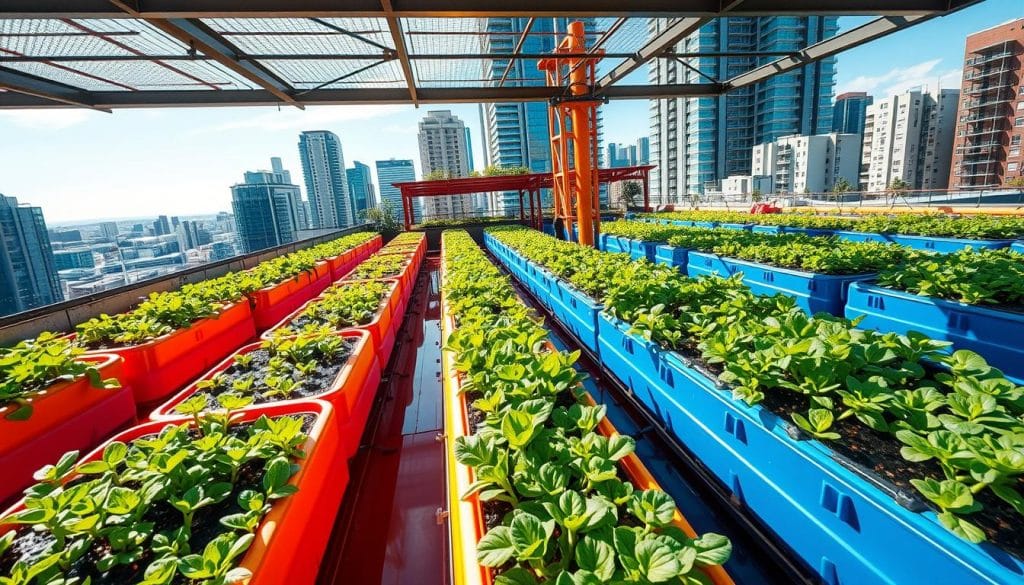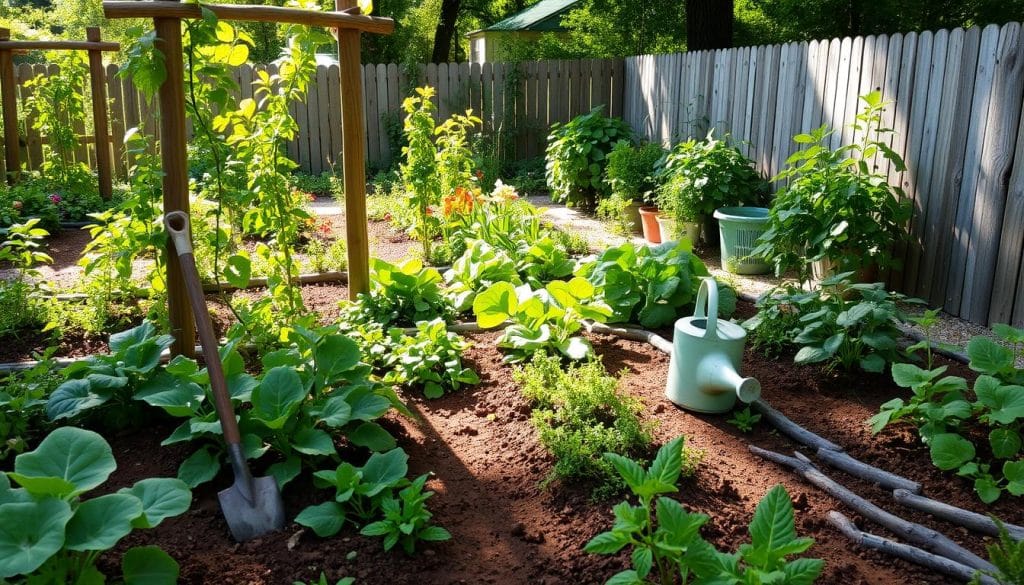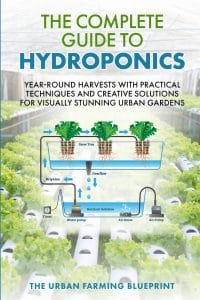Key Takeaways
- Traditional gardening usually costs less to start than hydroponics.
- Hydroponics uses way less water than traditional gardening, saving water.
- Hydroponics lets you grow crops all year, unlike traditional gardening which is season-based.
- Hydroponics keeps crops safe from pests and diseases, making food safer.
- Hydroponics saves resources, growing more food with less space and water.
Understanding Urban Hydroponics
Urban hydroponics is a new way to grow plants without soil. It uses water full of nutrients instead. This method is great for cities where there’s little room for gardens.
People living in cities can now grow veggies and herbs. They use special systems that help plants grow better and faster.
Definition and Overview
Urban hydroponics means growing plants without soil. It uses old ideas from the late 1800s. Now, it helps grow many types of plants, from flowers to food like lettuce and tomatoes.
How It Works
This method controls things like light and water. It makes sure plants get what they need. This way, plants grow well in special places.
It also saves a lot of water. Up to 90% less than regular farming. This is very helpful in dry places.
Types of Hydroponic Systems
There are many hydroponic systems. Each one is good for different plants and places. Here are a few:
- Nutrient Film Technique (NFT): A thin film of water with nutrients flows over plant roots.
- Deep Water Culture (DWC): Plants hang over water with nutrients, getting lots of oxygen.
- Aeroponics: Roots get misted with nutrients, getting lots of oxygen and nutrients.
These systems help cities grow more food. They make food safer and help the planet too.

Traditional Gardening Explained
Traditional gardening uses the earth’s natural resources to grow plants. It relies on soil’s nutrients for rich biodiversity and growth. This method is loved by many for its connection to nature and sustainable practices.
Features of Soil-Based Gardening
Soil-based gardening has key features that help plants grow well:
- Nutrient Availability: Soil’s natural nutrients support healthy plant growth.
- Biodiversity: Soil fosters a diverse ecosystem, improving soil health.
- Cultural Heritage: Gardening techniques passed down through generations show local wisdom.
- Minimal Resource Inputs: Garden beds need less care than hydroponic systems once set up.
Common Techniques Used in Traditional Gardening
Many techniques make traditional gardening productive and sustainable. They improve soil health and plant growth:
- Crop Rotation: Switching plant families prevents soil depletion and pest buildup.
- Companion Planting: Growing different plants together boosts growth and fights pests.
- Composting: Recycling organic materials adds nutrients and supports a healthy ecosystem.

Efficiency and Yield Comparison
Many things affect how much food urban hydroponics and traditional gardening can grow. Knowing these differences helps us grow more food in different places.
Urban Hydroponics Yield Potentia
Urban hydroponics has big advantages in growing food. Vertical farming can grow 50-100 times more food per square foot than old farming ways. This is because it uses special growing methods and keeps the right conditions all year.
Greenhouse farming also boosts yield by 10-12 times over old gardening. This is because greenhouses control the environment, letting plants grow longer. Crops like cucumbers and lettuces grow two to four times more in cities than in the countryside. This shows how urban hydroponics can change how we grow food.
Traditional Gardening Yield Constraints
Traditional gardening faces many challenges. Things like soil quality, weather, and seasons affect how much food it can grow. It also needs a lot of land, which limits how much food can be grown.
Yet, 15% to 20% of the world’s food is grown in cities. As cities get bigger, growing food in cities will become even more important. Knowing the limits of traditional gardening is key as cities expand.
Space and Resource Use
Cities are getting bigger, and we need better ways to farm. Urban hydroponics is great because it uses less space. It lets plants grow in tight spots.
This method uses vertical systems to pack more plants in. It’s a smart way to use land when it’s scarce.
Space Efficiency in Urban Hydroponics
Urban hydroponics uses vertical farming to grow more plants in less space. It’s a new way to farm that needs less land than old methods. This makes it perfect for small spaces like rooftops and balconies.
Land Requirements for Traditional Gardening
Traditional gardening needs a lot of land to grow plants. It uses big plots of soil. But, as cities grow, finding enough land becomes harder.
Water Usage: Hydroponics vs. Traditional Practices
Water is key for farming, and hydroponics uses much less of it. It can use up to 98% less water than old farming ways. This helps solve water problems in many places.
Hydroponics recycles water and uses nutrients carefully. This cuts down on waste. Old farming ways can waste a lot of water, harming the environment.
Environmental Impact
The world is worried about how farming affects the environment. Urban hydroponics is a good way to farm that’s better for the planet. It helps when cities grow and land for farming gets smaller.
Sustainability of Urban Hydroponics
Urban hydroponics uses a lot less water than old farming ways. For example, it needs about 20 L/kg/yr of water for lettuce. But old farming uses around 250 L/kg/yr.
Using hydroponics can make food production less harmful to the environment. Aquaponics can even make fish protein with less than 100 L/kg of water. This is important because we might face a 40% global water deficit by 2030.
Soil Degradation Concerns with Traditional Gardening
Old farming ways hurt the soil and the planet. Soil gets worn out, and we lose plants and animals. Only 4% of the US tries to keep land and water safe.
Big farms use more water and hurt water quality. This harms fish and other water creatures. We need new ways like urban hydroponics to fix these problems.
Initial Investment and Long-Term Benefits
Urban hydroponics and traditional gardening have different costs. This part talks about the money needed at the start and the benefits later on. Knowing these helps people decide what’s best for them.
Cost Analysis: Hydroponic Systems vs. Traditional Methods
Hydroponics need a lot of money at first for equipment and setup. You have to buy grow lights, nutrient solutions, and more. Even though it’s expensive at the start, it saves money later.
Traditional gardening costs less to start but can be more expensive over time. You have to pay for soil, pest control, and land care. These costs can make traditional gardening less profitable.
Maintenance Costs over Time
Hydroponics need regular care but can save money in the long run. They keep pests and diseases away, which means less need for chemicals. Traditional gardening needs more work and can cost more over time.
Hydroponics focus on being efficient. They save water and have steady crops. This makes them a good choice for saving money.
Conclusion
Urban hydroponics and traditional gardening have their own benefits and challenges. The world’s population is expected to hit 9.8 billion by 2050. Most of these people will live in cities, making sustainable food production key.
Urban hydroponics is a good answer to this problem. It uses much less space than traditional farming, up to 99% less. It also cuts down water use by up to 90%.
Hydroponics lets us grow food all year, no matter the weather or land quality. New tech in this field makes it more efficient. This makes urban hydroponics a strong choice for cities’ growing food needs.
Both urban hydroponics and traditional gardening are important for our future food. But, we need new farming ways to face the challenges ahead. Using controlled environment agriculture can help make our food systems stronger and more sustainable.
FAQ
What is urban hydroponics?
Urban hydroponics grows plants without soil. It uses water full of nutrients. This method helps grow food in cities where land is scarce.
How does a hydroponic system work?
Hydroponic systems control light, temperature, and nutrients. This helps plants grow fast and well. It’s better than regular gardening.
What are the main types of hydroponic systems?
There are Nutrient Film Technique (NFT), Deep Water Culture (DWC), and Aeroponics. Each delivers nutrients and water differently. They’re great for city gardens.
What are the benefits of traditional gardening?
Traditional gardening uses soil for growth. It gives plants nutrients and supports many species. Practices like crop rotation and composting help the soil.
How does the yield compare between hydroponics and traditional gardening?
Hydroponics often grows more food than traditional gardening. It uses better conditions and can grow more plants. Traditional gardening is limited by seasons and soil quality.
Is urban hydroponics more space-efficient than traditional gardening?
Yes, hydroponics uses space well with vertical farming. It fits in small city areas. Traditional gardening needs more land.
What is the environmental impact of urban hydroponics compared to traditional gardening?
Hydroponics is better for the environment. It uses less land and water. Traditional gardening can harm soil and pollute water.
What are the initial investment costs for hydroponic systems versus traditional gardening?
Hydroponics costs more to start. But, it saves money on labor and water in the long run. Traditional gardening is cheaper to begin but costs more to maintain.


